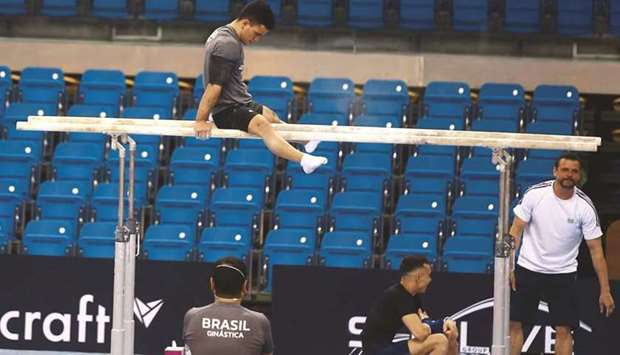There’s nothing that makes a fitness instructor cringe more than seeing someone exercise with bad form — shoddy alignment is dangerous and can lead to injury.
The response is visceral for trainers such as Anna Kaiser: “It makes my body hurt,” says the small-but-mighty dance-cardio guru, who works with celebrities from Kelly Ripa to Shakira. “You can’t take your workouts to the next level until you have proper form. It’s kind of irresponsible not to get it right.”
‘You can’t Take your workouts to the next level until you have proper form.It’s Kind of irresponsible not to get it right’
Here, influential trainers share the most commonly butchered exercise moves, plus some healthier alternatives you can handle on your own — even when you’re not under the watchful eye of a pro.
Skip: Single-leg dead lifts
In her famous dance-based fitness classes at AKT, Kaiser often sees people doing this balance-heavy move incorrectly. The exercise involves standing on one leg with weights in both hands, then bringing the weights to the ground as the back leg rises. Often, Kaiser sees spines curving and knees buckling. This could result in back pain and even a herniated disk, especially if heavier weights are involved, she says.
Try: Single-leg bridges

Kaiser recommends taking it to a mat to tone your glutes. Lying on your back, put one foot flat on the floor with the knee bent. Lift the other leg at a 90-degree angle with the toes pointed up. Raise the hips about 8 inches from the ground and pulse. The move works the same muscles as the single-leg dead lift — the glutes, the hamstrings and the inner and outer thigh muscles. “It’s easier to target the right muscles and also keep your back neutral,” Kaiser says.
Aim for three sets of 25 reps, then switch sides and repeat.
Skip: Standard bicep curls
You don’t get biceps like Alonzo Wilson’s by doing curls wrong. Still, he constantly sees people incorrectly using momentum — as opposed to strength — to lift the weights. Often, people lurch side to side with each curl, thrusting the weights toward their shoulders and letting them fall back to their sides and behind them. Doing it this way could result in a sore back, since the strain may cause inflammation of the lower lumbar spine, says Wilson, the founder of Tone House, a studio with locations on the Upper East Side and NoMad, which trains its classgoers as if they were professional athletes. The problems are magnified if you’re trying to show off with too-heavy weights.
Try: Twisted bicep curls

Wilson recommends a similar exercise, with an added twist to make it safer and more muscle-building. With your feet a hip-width apart, start by holding the weights at your side with your palms facing inward and the heads of the weights pointing straight forward. Hinging at the elbow, slowly pull the weight toward your shoulder, twisting your wrist so you reach the top with your palms facing your shoulder. Keep your core tight the entire time.
“That small twist helps you get more bang for your buck” — and reaches more of the arm muscles, Wilson says. As with the standard curl, make sure you’re not using momentum to propel the movement.
Aim for four sets of 12 reps, with a weight amount that won’t be too hard to control.
Skip: Kicking into a yoga headstand
Claire Fountain, the Upper West Side yoga instructor who’s coached celebrities such as LeBron James and Common, says she’s constantly seeing yogis improperly attempt headstands, especially on social media. “People think headstands are really impressive, but they get impatient, so they kick up into it, and that can be really damaging,” Fountain says, noting poor headstand form might result in neck or spine injuries, muscle pulls, dizziness or headaches. “Anyone with neck and upper-back issues — and some eye issues — should not practice them,” she says.
Try: Forearm plank to dolphin pose

To strengthen shoulder and core muscles, Fountain suggests mastering a progression before you commit to a full-on headstand: Work on transitioning from a forearm plank to a dolphin pose — basically a cross between a forearm plank and a downward dog.
Start in a forearm plank, with your elbows underneath your shoulders and your hands clasped together. Hold for two breaths. To move into dolphin, come up on your tiptoes and pike your hips up into a V-shape with a flat back, keeping your core tight and shoulders engaged, with your gaze back toward your feet. “This move will also help strengthen the muscles necessary to pull off a headstand with more control,” Fountain says.
Incorporate at least 10 progressions into your workout.
Skip: Elevated tricep dips
When most people think of workouts that will give them lean triceps, they think of this potentially dangerous exercise, says cross-training expert Jason Tran, who teaches indoor cycling at Swerve and high-intensity interval classes at the Fhitting Room. The exercises involve holding onto the edge of a bench from behind your back, then bending the elbows to dip the butt down to the ground. People do it wrong by curving their spine and letting their shoulders come up toward their ears, which can put a lot of strain on the rotator cuffs in the shoulder, Tran says.
Try: Tricep pushups
Aim for three sets of at least 10 pushups.
Skip: The curtsy lunge
A curtsy lunge involves stepping back and crossing one thigh behind the other as if you were doing a curtsy, often with hand weights. Even if you align the legs properly — with your back toe in line with your front heel — it could cause an abnormal hip rhythm and create a problematic angle in the knee, potentially leading to ligament pain or damage. “The cost is not worth the benefit for 99 percent of the people doing them,” says TMPLtrainer Dawn Marie Slocum.
Try: A reverse lunge

Stand with your legs about a hip-width apart and slide one of your feet directly back behind you, keeping the hips square. With weights in your hands, hover your back knee close the ground, so your front leg is at a 90-degree angle. Just by keeping your hips square, “You recruit the same amount of muscle, but the joints are in a less vulnerable space,” Slocum says of the move, which is especially good for your hamstrings and glutes.
Aim for three or four sets of 10-15 reps. Try to get to the point when you don’t want to do two more reps, but you still physically can. After that point, your form may suffer, Slocum says. “If the last rep doesn’t look like the first rep, then you know you’re at your stopping point.”
Source: nypost.com







Leave A Comment
You must be logged in to post a comment.